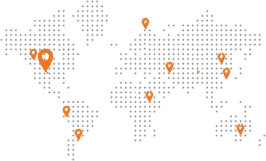19th U.S. Rock Mechanics Symposium, University of Nevada, Reno, Nevada, May 1978
Authors: J. F. T. Agapito (AAI), and J. W. Bennett and J. P. Hunter (Stauffer Chemical Company of Wyoming)
This paper describes part of a rock mechanics program being conducted at the Big Island Mine of Stauffer Chemical Company of Wyoming. The program objective is to determine the feasibility of mining two superimposed, 10-ft (3-m) thick, trona seams. The beds are separated by 33 ft (10 m) of marlstones and shales. The lower bed is 850 ft (259 m) deep. The mining method is room-and-pillar with a 60% extraction ratio.
A preliminary assessment based on a simple finite analysis indicated stress overlapping between the beds to be negligible with stability conditions similar to single-seam mining.
At present, part of the test area has been mined with superimposed pillars between the seams. Test mining consists of extracting a panel over an existing mined out area. This sequence was chosen because upper bed mining on a production scale did not commence until 1976 and the finite element analysis indicated there was no appreciable difference in mining either the upper or lower bed first.
Simple instrumentation showed that prior to upper seam mining the pillars in the lower bed were under full overburden load. Upper seam mining has increased pillar loading in the lower bed by 175 psi (1.2 MPa). This was accompanied by small downward movement of the strata between the seams. Observations and deformation measurements have indicated stable conditions. However, spalling of loose roof slabs and pillar corners has occurred in the lower seam as a result of upper seam blasting and residual fractures left from lower bed extraction.
Two-seam test mining is still in progress; results indicate agreement between the stability analysis done ahead of mining and actual experienced conditions. Instrumentation monitoring will be carried out for months after mining the test area. Future production from two-bed mining will be delayed for two years to assess time effects on stress and deformation after completion of the test area.
The program has established rock mechanics in the Big Island Mine as a practical tool to help provide maximum safety, resource recovery, and productivity. Additional stability analysis based on experience and instrumentation results will be used to evaluate future panel layouts and extraction ratios in long-range planning.
Downloadable PDF: Rock Mechanics Issues for Two-Seam Mining at the Big Island Trona Mine Stauffer Chemical Company of Wyoming


